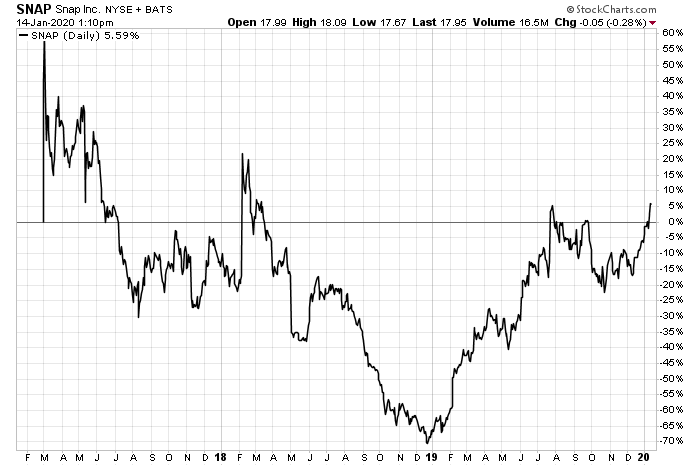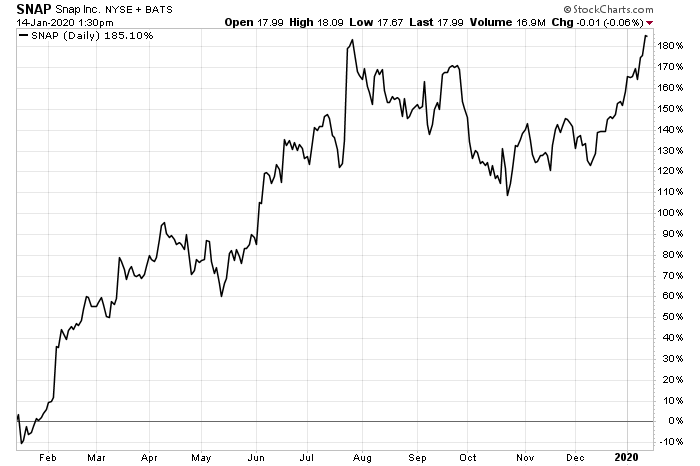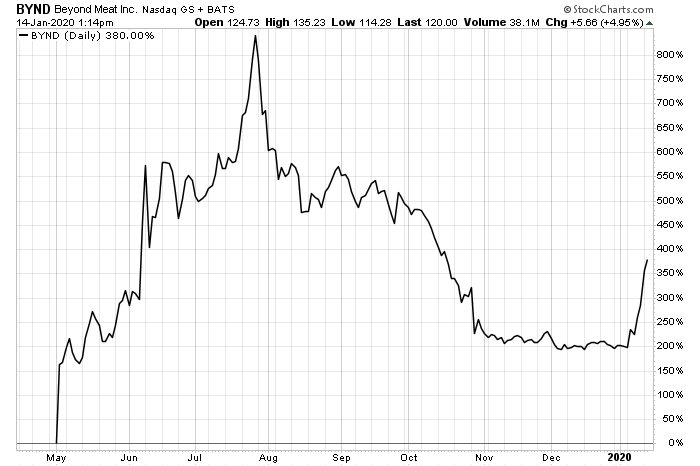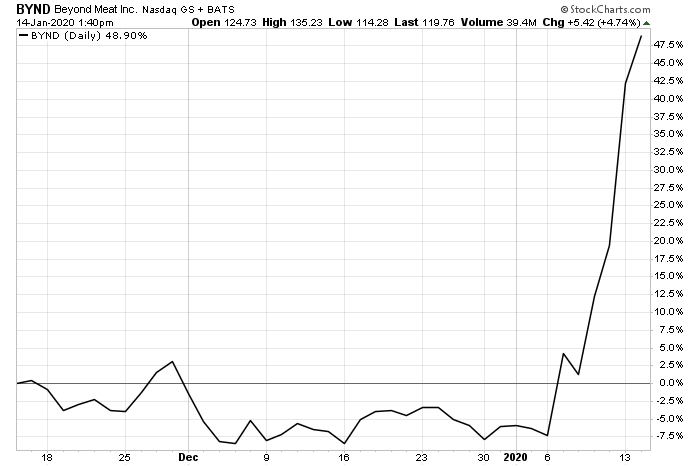How Best to Profit from Tech IPOs in 2020
Marijuana Business, Stocks, Finance, & Investing January 17, 2020 MJ Shareholders 0

 What the Market Is Telling Us About Tech IPOs
What the Market Is Telling Us About Tech IPOs
One of the most lucrative investments you can ever make is picking the right company from day one. Being in on the ground floor has made many investors into millionaires over the years.
It’s a simple equation, after all: support a great company before the rest of the market realizes just how great it is. That strategy has seen tech initial public offerings (IPOs) score huge gains for investors. The tech IPOs in 2020 are looking to be no different.
In 2019, we saw some truly massive companies finally hit the public market, to mixed results.
Both Lyft Inc (NASDAQ:LYFT) and Uber Technologies Inc (NYSE:UBER) went public in 2019 and came out of the gate limping. Neither of these tech stocks were able to find ways around their massive valuations hindering their potential in the eyes of investors (at least at the start).
Chart courtesy of StockCharts.com
Both companies, for instance, have immense revenues. Which makes the fact that both of them post hundreds of millions (sometimes billions) of dollars in losses all the harder to swallow.
After all, at its core, Uber and Lift’s business model is a simple one that’s hundreds of years old. It’s a taxi service, with the major innovation being the interface of an app (and the still-shaky use of freelance drivers).
It shouldn’t be all that hard to profit from that model, since taxi companies have been making money for decades. Yet, despite being the largest taxi services we’ve ever seen, both Lyft Inc and Uber Technologies Inc have been struggling to turn their high usage rates into profit.
And that lack of profit, in turn, has led to their stocks’ respective downfalls. Both companies’ share prices are down significantly from their IPO prices. It’s safe to say that these two tech IPOs were some of the most disappointing ones in 2019 (for now).
I say “for now” because, as I wrote in an earlier article, both LYFT stock and UBER stock could be on the rise.
In that article, I said that Uber (and to a similar extent, Lyft) can actually double an investor’s money. The reasoning is rather simple: these companies still have immense value, even if investors believe them to be bloated.
Contrast them with Snap Inc (NYSE:SNAP). As you can see in the below chart, SNAP stock did not have the easiest start on the stock market.
Chart courtesy of StockCharts.com
Impressing many with its business growth and usage rates, this social media stock came out of the gate with huge gains, only to see those gains disappear.
I was rather bearish on SNAP stock when it first hit the market, precisely due to this fact: growth is not profit and growth is not eternal. Eventually, you have to start making money to be a viable business.
Snap Inc couldn’t convince me that it was close to achieving that, and many investors were similarly unconvinced. The company’s shares plummeted by 70% in the months following its IPO.
But then something interesting happened in 2019: investors came roaring back to SNAP stock.
Chart courtesy of StockCharts.com
In 2019, SNAP stock was one of the strongest tech stocks around, showing gains of 185% (although it’s still only a few points up from its IPO price).
So what happened?
Investors thought that Snap was bloated when it first hit the market, so a correction set in. The stock fell to such a point that investors once more became interested in the company. That confidence quickly grew into a swell that lifted SNAP stock back to relevancy.
And that brings us back to Uber stock and Lyft stock.
The two companies are similar to Snap in that they have gigantic user bases and have suffered from bloated valuations and a lack of profits. All three stocks were punished early on post-IPO, and now I believe Uber and Lyft stock can turn things around.
So the lesson here for investors is that tech IPOs are about more than just their opening weeks on the market. Those opening months can be one of the worst times to invest in an exciting new tech IPO, especially in the cases of larger, more-anticipated IPOs.
Therefore, playing the long game, waiting out the dip, and investing at a low point can result in huge gains.
Buying the Dip on Tech IPOs
Beyond Meat Inc (NASDAQ:BYND) is another fantastic example of how to make money from volatile tech IPOs.
Chart courtesy of StockCharts.com
Beyond Meat was one of the best tech IPOs in 2019, seeing massive gains that were, for a large part, sustained from the stock’s opening price. But for those who bought it at its zenith, Beyond Meat stock has been a huge disappointment.
After the stock surged upward with gains approaching 1,000%, it was doomed to fall back to Earth eventually—and that’s exactly what happened.
But over the past two months, we’ve seen a resurgence by BYND stock.
Chart courtesy of StockCharts.com
Sparing you the details, essentially Beyond Meat stock spiked again because, among other things, the company announced plans to enter the extremely lucrative Chinese market.
BYND stock saw a major dip and then rose by about 50%. That’s a very healthy return.
The lesson is the same as with Snap: tech stocks are going to produce a lot of ups and downs, especially in the early aftermath of their IPOs.
Being able to play those ups and downs correctly is a way to see massive gains in short order.
It happened with Snap stock, it happened (to a lesser extent) with Beyond Meat stock, and it will likely happen again with a number of tech stocks in 2020.
So, as an alternative to playing the tech IPO game the traditional way of going all in on companies that are big on promise but small on results (at least as far as profits go), one solid way to earn money is to wait out their eventual corrections.
It’s the classic adage of buying low and selling high, but specified for tech IPOs.
The tech sector is known to be big on hype and wild turns. As such, being able to wait out the initial surges and falls gives investors a chance to earn massive profits from the aftermath of these events.
Furthermore, it also means that tech IPOs that have come and gone are by no means reasons to abandon a stock.
For instance, just because you weren’t there for the initial BYND stock surge during its IPO doesn’t mean you can’t see massive returns for your investment (as evidenced above).
And in the case of Snap Inc, sometimes missing the opening rush is actually a good thing.
Sure, you could have made a healthy profit if you had bought Snap stock early and sold it before it dipped, but those gains would have paled in comparison to having purchased the stock in early 2019. Sometimes waiting is the right move.
I’d be remiss to not mention that I’m glossing over a lot of details about these tech companies. Each of them are massive, multi-billion-dollar ventures with a ton of moving parts that help influence their stock prices.
Still, that doesn’t void the most important lessons here: 1) tech IPOs are among the best ways to make money on the stock market and 2) being first isn’t always the best way to profit.
Analyst Take
The best tech IPOs of 2020 are likely going to result in big gains for early investors, that’s true. But the most profitable tech stocks could end up being the ones that lose early on.
With so much talk about bubbles these days, and the overvaluation of tech stocks in particular, I anticipate that we’ll see a number of dud tech IPOs in 2020 and beyond.
But as shown above, there’s a good chance that a tech stock that starts out slow can provide large gains down the line. It has happened many times before and it will probably happen again.
MJ Shareholders
MJShareholders.com is the largest dedicated financial network and leading corporate communications firm serving the legal cannabis industry. Our network aims to connect public marijuana companies with these focused cannabis audiences across the US and Canada that are critical for growth: Short and long term cannabis investors Active funding sources Mainstream media Business leaders Cannabis consumers
















No comments so far.
Be first to leave comment below.